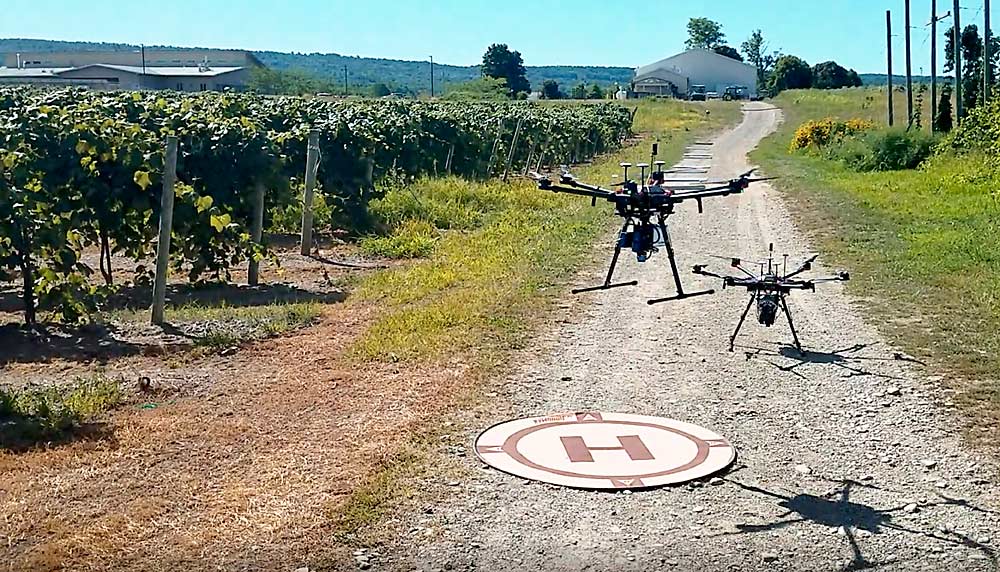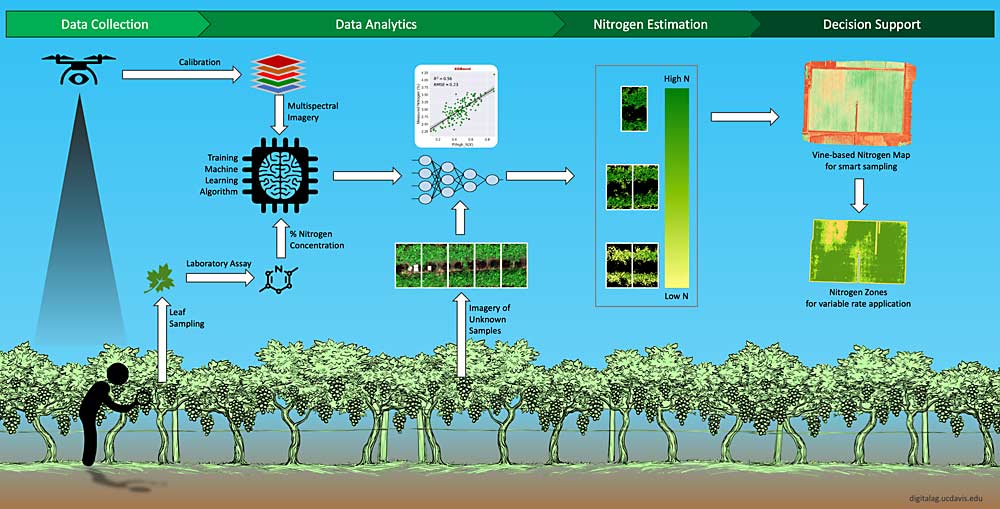
What if grape growers had a tool they could just point at a vine and it would tell them the vine nutrient status? Such insight could usher in an era of precision nutrient management.
Russell Smithyman, director of viticulture at Chateau Ste. Michelle, hit upon the potential of such a tool as he was brainstorming research initiatives during a committee meeting of the National Grape Research Alliance, NGRA. The organization exists to foster collaborations between grape producing regions and sectors, offering seed money to help develop and support research that fits with industry priorities.
“We can really think big and go out of the box to support things that can’t be done at the state or local level and go after big grants to tackle big problems,” Smithyman said of the NGRA, for which he serves as board chair.
This fall, the U.S. Department of Agriculture agreed with his vision and granted the first $1 million installment of a planned $4.75 million over four years to a team of 14 scientists at seven research institutions to develop tools for remote sensing of the nutrient status of grapevines, along with research on the nutrient needs of modern vineyards, to create a better foundation for applying the insights of new nutrient sensors.
“We have two main objectives: We want to find some way of remote sensing the nutrient status of entire vineyard blocks, at least for nitrogen, phosphorus, potassium, at different times of the year and spatially across the vineyard blocks,” said Markus Keller, viticulture professor at Washington State University and director of the new High-Resolution Vineyard Nutrient Management project. “Because you cannot do that without ground-truthing, the second objective is to generate a lot of data on the ground: tissue samples from the plants to use to ground-truth the remote sensing data.”
Wine grapes, table grapes, juice grapes and raisin grapes may all have different nutrient needs, compounded by differences in soils and regional climate, but the goal of the project is to deliver tools that allow growers to detect and respond to nutrient problems before they take a toll on fruit quality, Keller said.
The project includes Keller and three WSU colleagues: Qin Zhang, Manoj Karkee and Jim Harbertson; Terry Bates and Justine Vanden Heuvel of Cornell University; Patty Skinkis and James Watson from Oregon State University; Tony Wolf and Amanda Stewart from Virginia Tech; Alireza Pourreza and Matthew Fidelibus from the University of California, Davis; Jan van Aardt from Rochester Institute of Technology and Paul Schreiner with USDA’s Agricultural Research Service.
“It’s the dream team of vineyard nutrition. I’m really excited to work with all of them,” Keller said.

Nitrogen sensing spectrums
The most common remote sensing tools today are multispectral cameras that collect data to create vegetation index maps, such as the NDVI, but technology today allows researchers to begin to look at far more wavelengths to detect “spectral signatures” of vines under stress that serve as early warnings of diseases or nutrient and water status.
“NDVI is a very general index; it correlates with everything like water, vigor, disease, any kind of stress. It gives you the overall health indication of the plant,” said Alireza Pourreza, an extension specialist with the University of California, Davis. With data collected by a multispectral camera — based on which wavelengths of light a photosynthesizing plant absorbs and reflects — researchers can analyze about a dozen different vegetation indexes, such as NDVI and NDRE.
Starting in 2018, Pourreza and his colleague, Matthew Fidelibus, began a trial in a table grape vineyard to see if any of these existing indexes could pick up on differences between nitrogen-deficient vines and those with excess nitrogen. They found they can reliably detect some variability — but without as much specificity as they’d like.
So, with the help of the new grant, Pourreza and other engineers on the project are turning their attention to hyperspectral cameras that look at hundreds of narrow wavelengths, rather than five broader bands that the commercially available multispectral cameras do.
“It will enable us to go deep and explore that fundamental link between nitrogen and the spectral signature,” he said. “And we need to figure out the temporal variability — the model that we develop for bloom cannot be used for veraison.”
Viticulturists will set up trial blocks in vineyards with known nutrient problems, Keller said, with replications of varying nutrient applications for the hyperspectral sensors to analyze. Then, machine learning will help them sort through a mountain of sensing and tissue sample data to find wavelengths that appear strongly correlated to the nutrient deficiencies or excesses, said Manoj Karkee, an agricultural engineer at WSU.
“The hope here is the nitrogen deficiency would excite different wavelengths versus phosphorus deficiency versus water deficiency,” said Karkee, who also uses the remote sensing approach to look at water stress.
Once engineers have found the right spectral signals to look for, some of the newer multispectral cameras available to growers could be set to target those nutrient-deficiency-specific wavelengths, Pourreza said.

Tech, translated
To make such sensor information actionable, growers will need a framework to use it, said Terry Bates, director of the Cornell University Lake Erie Research and Extension Lab.
“The big picture is measure, model, manage,” he said. “You can’t manage what you can’t measure.”
His role with the project includes helping growers understand how to use spatial data on nutrient status to do variable rate fertilization. This aspect of the project builds on work Bates did as part of another SCRI-funded, NGRA-backed project known as the Efficient Vineyard project, which looked at the use of mapping tools to improve management of crop load, canopy and soils.
In Eastern juice grape vineyards, the crop takes a lot of potassium, so potassium deficiency — or black leaf — is a common problem. Growers who apply liquid potassium could quite easily translate nutrient maps from the sensors into variable rate spraying, Bates said.
In every region and sector, growers face different nutrient challenges. Some rely on tissue sampling recommendations developed half a century ago, which may or may not be relevant to their cultivar or production goals, while others put on fertilizer every year just because that’s what their dad did, Keller said. In the fertile, wet Willamette Valley, nutrient management means competitive cover-cropping to pull out nutrients, said Oregon State University viticulture professor Patty Skinkis.
The ground-truthing data collection necessary to test the sensor technology will also help answer fundamental questions about the relationship between nutrient status, vigor, yield and fruit quality in different regions and cultivars, said Tony Wolf, viticulture professor at Virginia Tech. “We just don’t have a good foundation for making recommendations,” he said.
The value of nutrient sensors, once proven, depends on the economic impact of better nutrient management. To answer that piece of the puzzle, Skinkis plans to use an approach called meta-analysis, which brings data from many different research projects together to find broad trends in a complex field of research.
“There’s all this data out there and we never use it,” she said, referring to past research projects that collected nutrient tissue analysis as background information in other trials. As long as studies collected nutrient levels and yield, the data can add to what Wolf, Bates, Keller and others collect during this project to help illustrate the benefits growers stand to gain from modernizing nutrient management.
Those findings will also guide the researchers to the places where sensing tools and decision aid models would have the most impact.
“We couldn’t just go into this focused on the sensors, because there are these knowledge gaps in nutrition,” she said. “We want something that has a benefit for everyone, across the U.S., across markets, across climates.”
—by Kate Prengaman






Leave A Comment